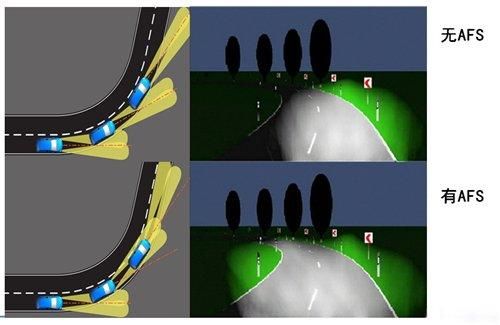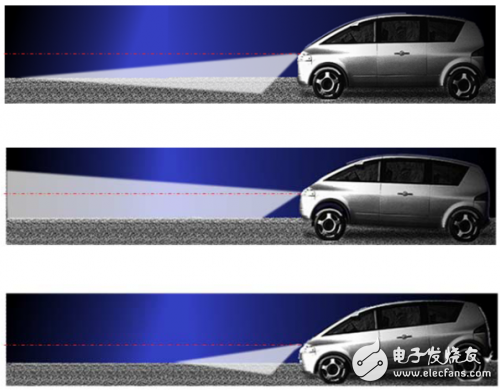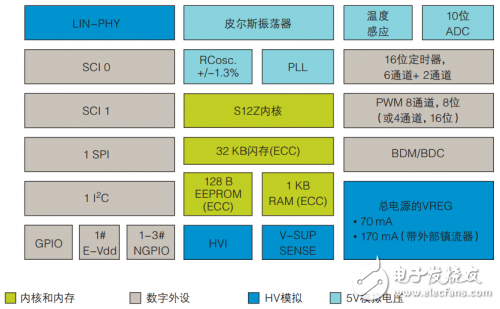0 Preface
Car headlights are an important safety component in cars. At present, the illumination angle of most car headlights is fixed. When the car is driving on a curve, the illumination field cannot meet the driving requirements because the beam cannot be deflected. Therefore, when driving at night, there will be a certain "blind zone" due to the driving angle problem, which will affect the safety of the driving to a certain extent. In the case of fixed illumination, this blind zone is inevitable, so the "AFS Light Follow-up Steering System" came into being. It can automatically adjust the direction of the headlight beam according to the car's steering signal and vehicle speed signal, ensuring that the vehicle will turn into the driver's field of view without delay when turning, providing the driver with the best lighting effect and ensuring nighttime. The safety of turning the car improves the active safety of the car.
As shown in Fig. 1, the AFS system uses the steering wheel angle of the vehicle during turning and the instantaneous vehicle speed as the control parameter input. According to the designed control algorithm, the headlight angle corresponding to the vehicle speed and the steering wheel angle is obtained, and the target angle is used as the target angle. Follow-up adjustment of the headlights of the car. At the same time, by calculating the sensor signals of the front and rear axles of the vehicle body, the height position of the headlights is automatically adjusted to meet the lighting requirements of different road gradients. This paper proposes an AFS execution controller design based on S12ZVL, which realizes LIN communication with the AFS main control module and drives the stepper motor to rotate the HID lamp.


Figure 1 AFS system renderings
1 S12ZVL Features
The S12ZVL family is part of the S12 MagniV mixed-signal microcontroller portfolio, providing intelligent, optimized integrated high-voltage components. Based on LL18UHV technology, this new series combines highly reliable 180nm non-volatile memory and high-voltage analog components on a single chip that withstand the rigors of automotive environments during load dumps. The S12ZVL product system integrates a LIN physical layer, an ESD-protected 12V input pin (capable of ADC measurements), and an automotive regulator operating between 3.5V and 40V (on-chip and slice for Hall or RGB LEDs) The external function provides a stable power supply). The S12ZVL family includes expandable and pin-compatible MCUs with a wide range of memory and package options. It re-uses the latest S12Z core, IP and tools to easily migrate from existing S12 16-bit products. In addition, the S12ZVL MCU integrates key features including ECC functionality on all memory (flash, EEPROM and RAM) and an on-chip oscillator accurate to 1.3%, which eliminates the need for external crystal oscillators or resonators for LIN communication. Its structural block diagram is shown in Figure 2.
At the same time, the S12ZVL series includes the first 16-bit MCUs belonging to the Freescale Safe Assure Functional Safety Assurance Program, designed to meet the functional safety standards required by ISO 26262 (ASIL A).

Figure 2 S12ZVL series structure block diagram
2 AFS executive controller design
The AFS actuator consists of a series of motors and optical mechanisms. Generally, there are projection headlights, an adjustment motor that adjusts the vertical angle of the headlights, a rotating electric machine that adjusts the horizontal angle of the headlights, a movable grating that adjusts the basic light type, and some additional lamps. Such as corner lights and so on.
As shown in Fig. 3, the electronic control unit LCM obtains accurate information of the steering wheel rotation angle, the vehicle body speed and the vehicle body inclination from the steering wheel angle, the vehicle speed, and the vehicle body height displacement sensor through the CAN bus. The angle and speed information are accurately calculated by the LCM module to generate an output signal, and the left and right actuators are separately controlled by the LIN bus communication to control the rotating motor to perform horizontal rotation of the headlight, and the tilt information is controlled to increase the headlight of the motor. Rotate vertically.

Figure 3 AFS system structure
Single Gang Trailing Socket,Philippines Charger Socket,Philippines Sockets Plugs,Power Outlet Converter Philippines
Heikki Technology Co., Ltd. , https://www.heikkipower.com